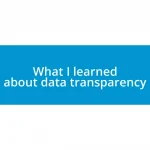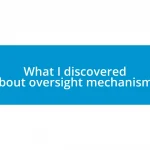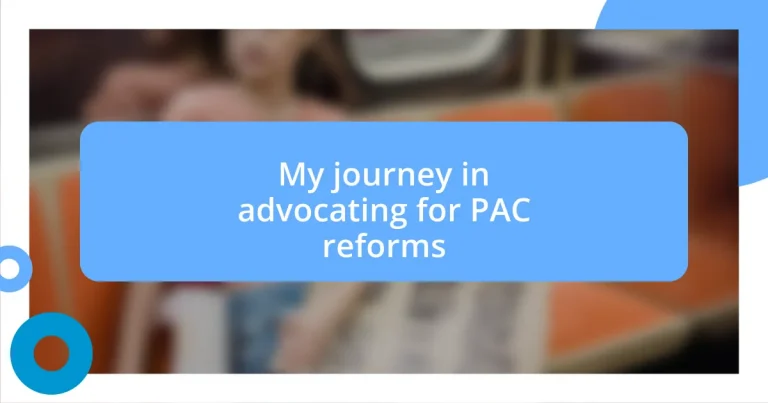Key takeaways:
- PAC reform is essential for restoring trust in democracy and amplifying the voices of marginalized communities.
- Effective advocacy strategies include storytelling, coalition building, and leveraging digital platforms to enhance engagement.
- Engaging with policymakers requires preparation, follow-up, and a blend of emotional and factual narratives.
- Sustaining advocacy momentum relies on strategic planning, community involvement, and celebrating small victories.
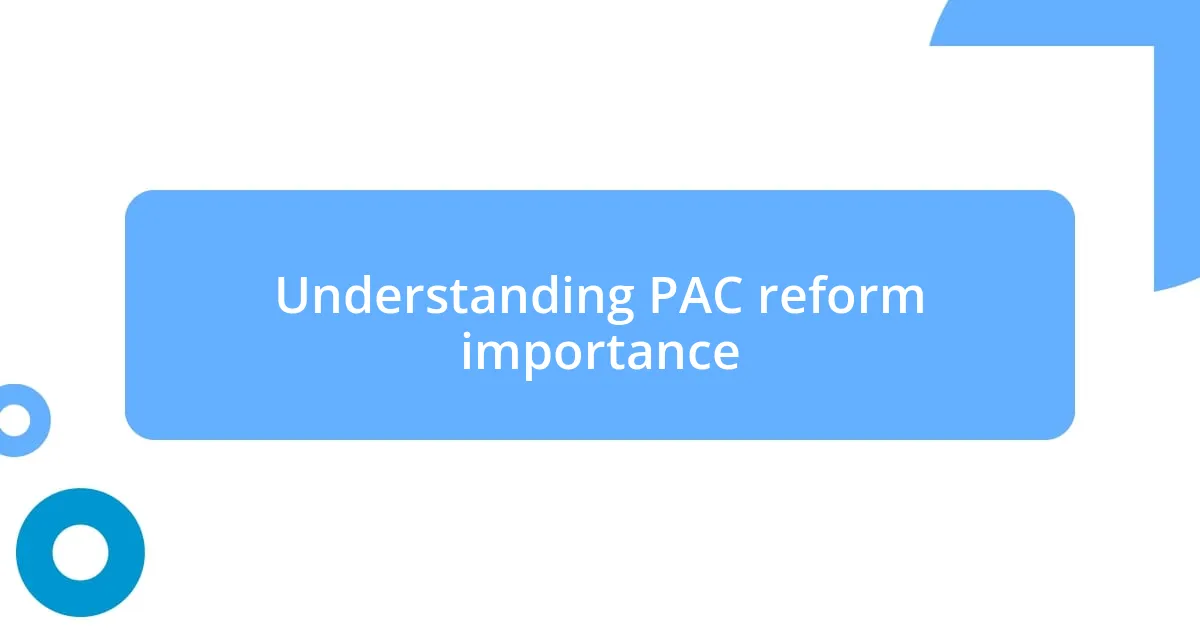
Understanding PAC reform importance
Understanding the importance of PAC reform is crucial in a society where transparency and accountability are often overshadowed. I’ve witnessed firsthand how the influence of Special Interest Groups can skew the political landscape, making it seem like the voices of ordinary citizens are drowned out. It makes me wonder: how can we expect a fair representation when money often speaks louder than the people?
I remember attending a town hall meeting once where constituents expressed frustration over policy decisions. It was clear that many felt their concerns were ignored because those in power catered to bigger donors instead. This experience drove home the point that reforms aren’t just about changing rules but also about restoring faith in our democratic processes. Isn’t trust in government something we should all strive for?
When we talk about PAC reform, it’s not simply a political issue; it’s deeply personal. Reform has the potential to elevate the voices of the marginalized and ensure that every individual has a stake in our governance. Reflecting on these stories, I can’t help but feel that implementing effective reforms could be a turning point in creating a fairer system for all. Wouldn’t you agree that everyone deserves a seat at the table?
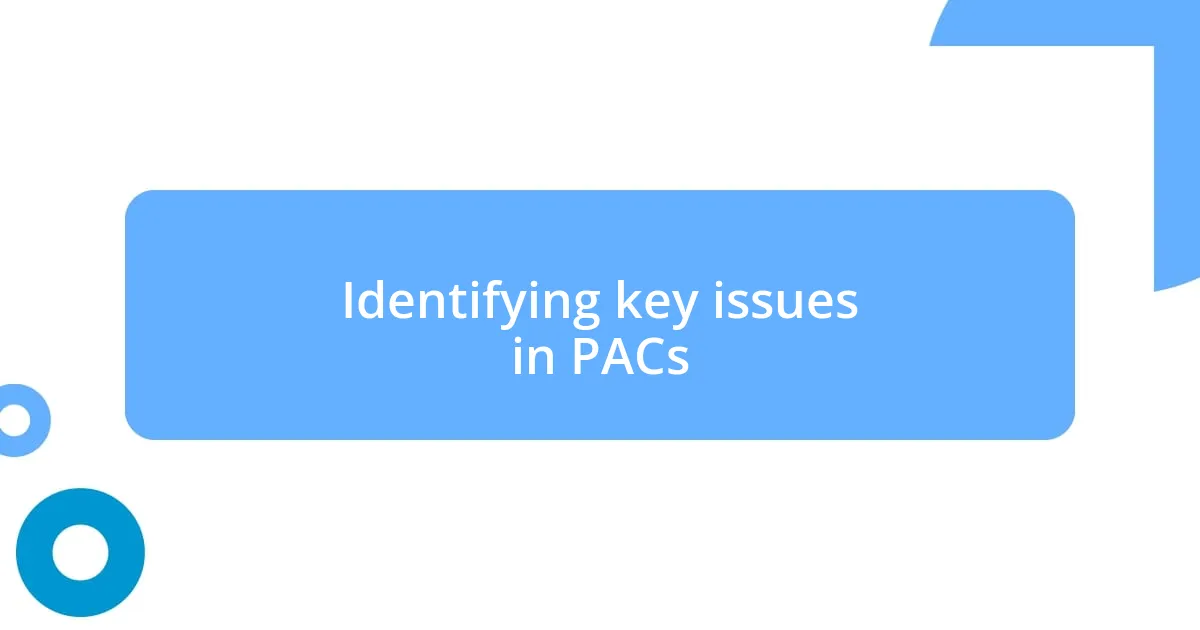
Identifying key issues in PACs
Identifying key issues in Political Action Committees is essential for understanding the broader implications of PAC influence on our political environment. Throughout my journey, I’ve often noticed how a lack of transparency in PAC funding creates an uneven playing field. For instance, during a community campaign that I participated in, we unearthed connections between local PACs and major corporations. This realization not only shocked our team but also fueled our determination to push for clearer disclosure laws.
Here are some of the critical issues I’ve identified regarding PACs:
- Transparency: Many PACs operate without sufficient oversight, leading to hidden agendas that cloud public understanding.
- Influence of money: The financial power of PACs can disproportionately affect policy outcomes, favoring elite interests over ordinary citizens.
- Voter disengagement: When citizens perceive that PAC money dictates elections, it can lead to apathy and lower voter participation, undermining democracy.
- Lobbying connections: Some PACs have close ties with lobbyists, creating conflicts of interest that prioritize special interests over the constituents’ needs.
Reflecting on these matters, I can’t help but feel a sense of urgency to take action. It’s troubling to think that the voices of hardworking individuals can be overshadowed by the clamor of money in politics. Each interaction with citizens who feel disenfranchised only reinforces my belief that highlighting these issues can generate the necessary momentum for significant reforms.

Strategies for effective advocacy
Advocacy for PAC reforms requires a blend of personal connection and strategic action. I find that storytelling is one of the most powerful tools in this endeavor. I recall speaking with a woman at a local community event who shared her concerns about how PACs affected the quality of life in her neighborhood. Her heartfelt story resonated with many in the room, making the issue relatable and approachable. Sharing personal accounts like hers helps foster a sense of urgency and the importance of reform among diverse audiences.
Another effective strategy involves building coalitions with like-minded individuals and organizations. In my experience, collaboration amplifies our voices and resources. For example, I once teamed up with grassroots organizations, bringing together volunteers to organize advocacy events. We found that when we unified our efforts, public engagement soared, showing that when various voices unite for a common cause, the impact can be profound. How have you seen collaboration enhance advocacy efforts in your own experiences?
Lastly, utilizing digital platforms for outreach cannot be overstated. Social media campaigns can mobilize support quickly, as I discovered during a coordinated effort to raise awareness about PACs. We created shareable content that not only informed people but also encouraged them to share their thoughts. Seeing community members engage online made me believe in the power of digital advocacy. It’s an essential strategy in today’s world, where information travels fast, and the right message can spark a movement.
| Strategy | Description |
|---|---|
| Storytelling | Utilizing personal anecdotes to illustrate the impact of PACs fosters relatability and urgency. |
| Coalition Building | Partnering with others strengthens advocacy efforts and broadens the audience. |
| Digital Outreach | Leveraging social media and online platforms boosts engagement and facilitates quick mobilization. |
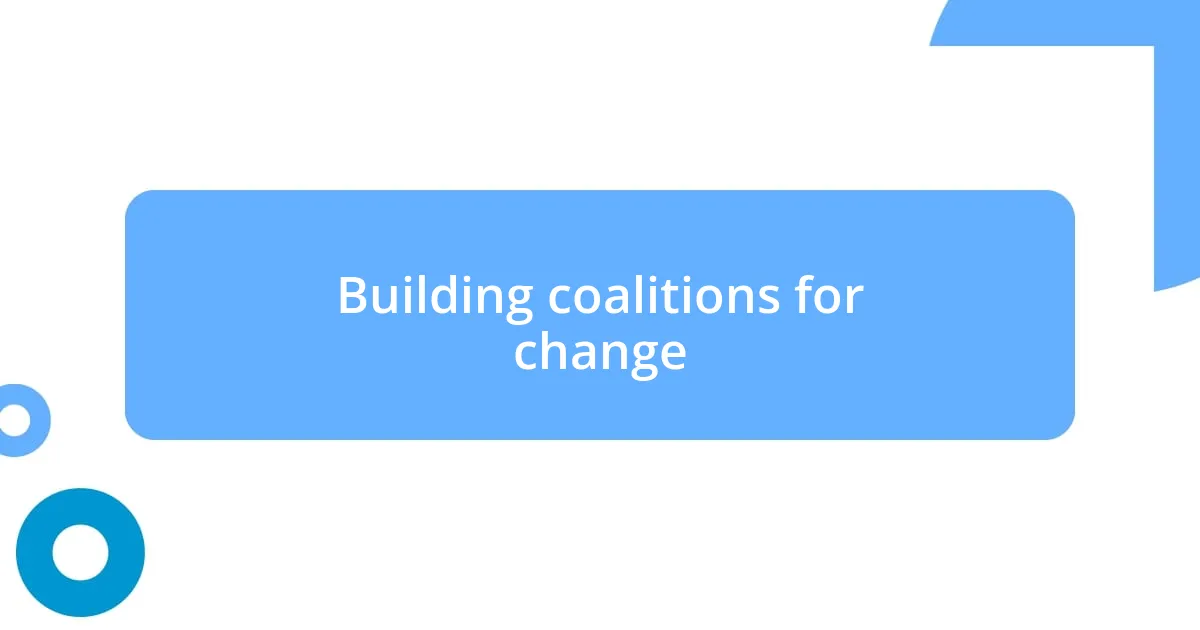
Building coalitions for change
Building coalitions for change is a dynamic journey. When I first embarked on this path, I found myself reaching out to local activists who shared my vision for PAC reforms. We started meeting regularly, sharing our thoughts over coffee and brainstorming ways to amplify our voices. The energy in those meetings was palpable, as if we were igniting a fire. Isn’t it fascinating how a small group of dedicated individuals can come together to create something monumental?
One memorable experience was joining forces with a local environmental organization. We shared concerns about how PACs influenced city planning and policy decisions that directly impacted our community. By combining our resources, we hosted a town hall meeting that drew an unexpected crowd. The room buzzed with energy as residents voiced their frustrations and dreams for a more equitable future. That moment taught me the power of unity; when we come together, our individual stories coalesce into a powerful narrative that demands attention. Have you ever witnessed such a moment of solidarity that sparked change in your circles?
Networking goes beyond just making connections; it’s about nurturing relationships that inspire action. I remember attending a regional conference where I met advocates from different states, each with unique perspectives yet united in purpose. We exchanged ideas, strategies, and even challenges. Those conversations opened my eyes to the various ways coalitions can take shape, each with its own flavor and strength. It reaffirmed my belief that every coalition is a living, breathing organism, capable of evolving and overcoming obstacles together. How have your connections influenced your advocacy journey?
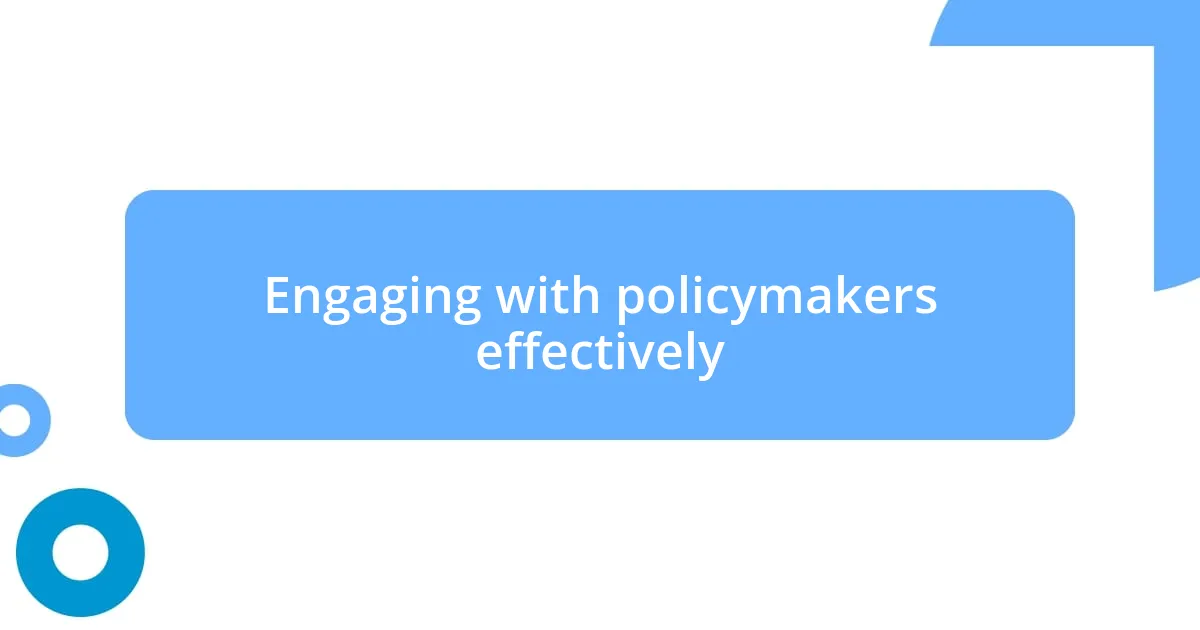
Engaging with policymakers effectively
Engaging with policymakers effectively goes beyond mere discussions and meetings; it requires preparation and a genuine understanding of their priorities. I remember attending a town hall where several local leaders spoke passionately. I listened intently, noting their interests and concerns. When my turn came to speak, I was able to connect the dots between their objectives and the urgent need for PAC reforms, which made my message resonate more. Isn’t it amazing how aligning our goals with those of policymakers can create a bridge for meaningful conversations?
Following up after initial meetings is another critical step I’ve learned to prioritize. After meeting with a council member, I sent a personalized thank-you note that referenced specific points from our discussion. It was gratifying when they responded positively, expressing interest in my proposed follow-up actions. This simple act showed how a thoughtful gesture could reaffirm our connection and keep the momentum going. Have you found that personal notes or follow-ups can play a role in nurturing relationships with those in power?
An essential aspect of engagement is being prepared to provide data and personal stories that illuminate the issues surrounding PACs. I recall a time when I presented to a legislative committee. I combined compelling statistics with anecdotes from community members whose lives were noticeably impacted by PAC activities. The look of genuine interest on their faces affirmed my approach. Reflecting on that experience made me realize how crucial it is to show both the human and statistical side of advocacy. How often do you think we miss opportunities to blend emotional and factual narratives in our advocacy efforts?
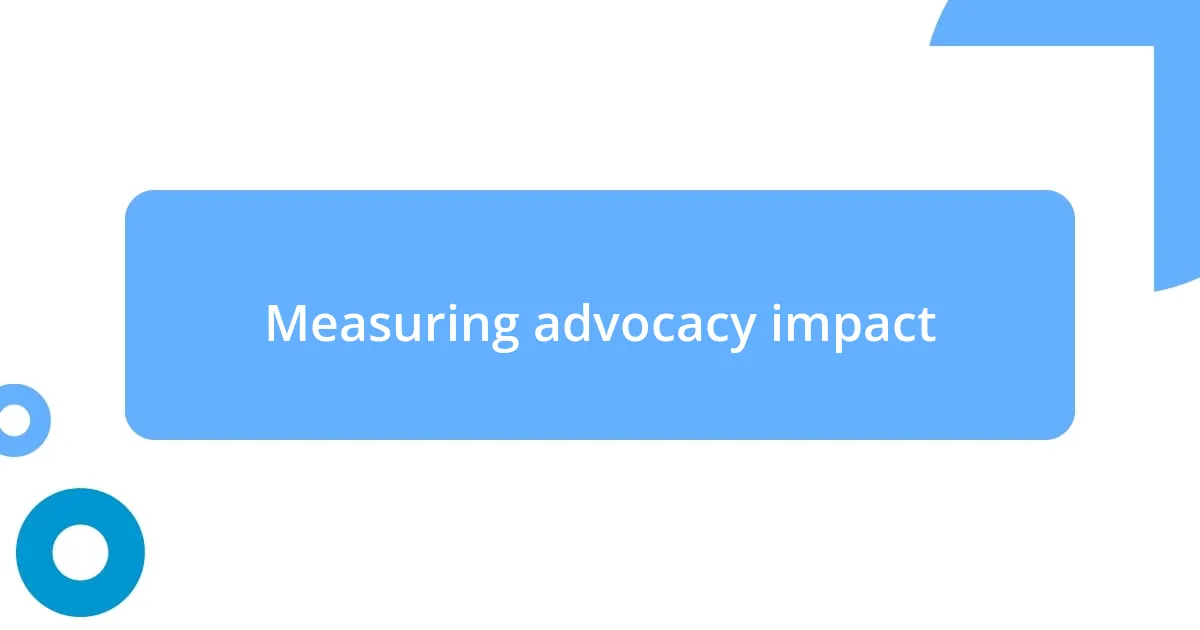
Measuring advocacy impact
When assessing the impact of advocacy efforts, I often turn to both quantitative and qualitative measures. For example, after organizing a campaign for PAC reforms, we tracked social media engagement and attendance at our events. Seeing the numbers grow was thrilling, but the real impact was felt through personal stories shared at community meetings. Isn’t it fascinating how data can paint a picture, yet stories can make it come alive?
One pivotal moment for me was conducting a survey post-campaign, where participants shared how our efforts influenced their understanding of PACs. The feedback poured in, revealing how advocacy not only raised awareness but also inspired individuals to take action in their own communities. I remember reading one response that said our initiative reignited their hope for change. Have you ever had a moment where you realized your voice could inspire others to stand up?
Finally, I’ve learned about the power of follow-up evaluations. After a particular advocacy drive, I organized a debriefing session with my coalition members. Reflecting together on what worked and what didn’t helped us grow and adapt our strategies for future initiatives. It was rewarding to hear my peers articulate how our efforts had sparked dialogue in their networks. How often do we take the time to reflect on our journey, learning from our experiences to refine our approach?
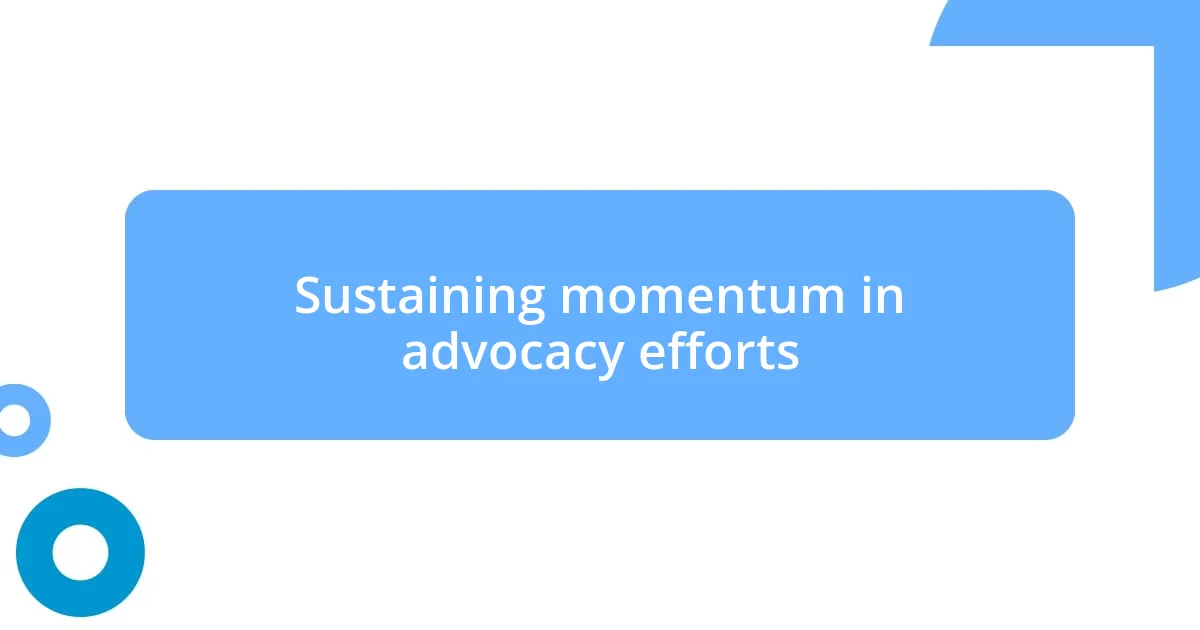
Sustaining momentum in advocacy efforts
Staying the course in advocacy work can be daunting, but I’ve discovered that strategic planning is key. For instance, after kicking off a campaign for PAC reforms, we established a detailed calendar of events and checkpoints to ensure we didn’t lose steam. I vividly remember our team huddling around a whiteboard, brainstorming tactics to maintain engagement month after month. Have you ever experienced the empowering feeling that comes from having a clear plan and sense of direction?
Another aspect I’ve learned to embrace is the importance of community involvement. Regular check-ins with supporters not only keep them informed but also foster a sense of ownership in our mission. During one outreach event, I was struck by the enthusiasm of a local volunteer who shared a personal story about how PAC practices affected her family. That moment reminded me of the powerful motivation that grassroots engagement can fuel. How often do we overlook the human connections that keep our advocacy vibrant?
Finally, celebrating small victories has proven essential for sustaining momentum over time. After securing minor changes in policy that aligned with our goals, we held an appreciation gathering. I recall the energy in the room as we shared stories of our impact, igniting a renewed spirit to tackle larger challenges ahead. I’ve found that acknowledging progress helps to solidify commitment to the cause. What small victories have you celebrated that renewed your drive in advocacy?


